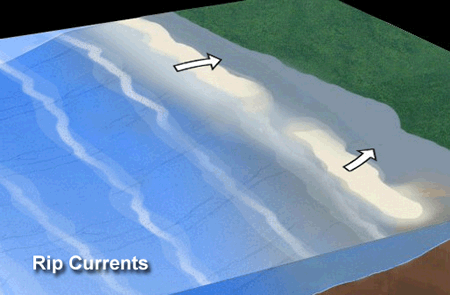A rip current forms when part of a longshore current is drawn away from the coast – perpendicular to the beach.
Courtesy of NOAA
Currents at the Coast
Ocean waves often move towards a beach at an angle. This moves water along the coast in a longshore current. Longshore currents grow stronger when the waves come towards the beach at a large angle. The currents also are stronger if the waves are very large, and if the beach has a steep slope.
Longshore currents move sand along the beach, eroding it from some areas and depositing it in other areas. This process is called longshore drift and it is able to, over time, move entire islands in the direction of the current. Places with longshore drift need new maps made as the shape of the coastline changes over time.
Longshore currents can carry more than just sand. They can carry people too. Thus, these currents can be very dangerous for people swimming in the ocean. Rip currents that carry swimmers into deep water form when part of a longshore current moves away from the beach. This happens usually where there is a change in the shape of the seafloor.
The water in a rip current moves fast - at one to two feet per second and some are as fast as eight feet per second. If a person swimming is caught in a rip current, they will be swept far from shore. But because rip currents only happen in small areas, usually not more than 25 meters (80 feet) wide, swimming parallel to the shore should get the person out of the current.
Last modified September 19, 2008 by Lisa Gardiner.
You might also be interested in:
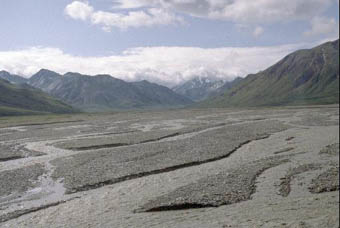
If you sneeze into a pile of dust, the little particles fly everywhere. But if you sneeze into a pile of rocks, they will stay put. It takes more force than a sneeze to move those rocks. Winds and water
...more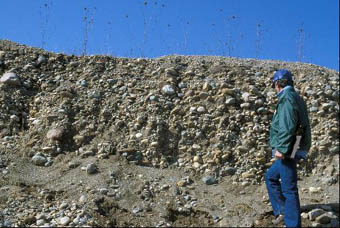
When water or wind loses energy and slows down, sediment can no longer be carried in it. The particles fall through the water or air and form a blanket of sediment on the bottom of a river, a lake, ocean,
...more
The water at the ocean surface is moved primarily by winds that blow in certain patterns because of the Earth’s spin and the Coriolis Effect. Winds are able to move the top 400 meters of the ocean creating
...more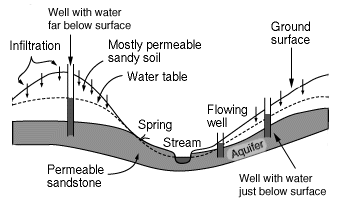
An aquifer is the name for a layer of rock which is capable of holding a large amount of water. Some layers are better at holding water than others, for example a layer of sandstone can hold a good deal
...more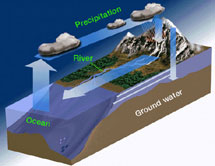
Carbonate is a name for rocks and minerals which contain a molecule made of both carbon and oxygen known as CO32-. (CO32- is also known as the molecule carbonate). Limestone is an example of a calcium
...more
One process which transfers water from the ground back to the atmosphere is evaporation. Evaporation is when water passes from a liquid phase to a gas phase. Rates of evaporation of water depend on things
...more
Rivers are very important to Earth because they are major forces that shape the landscape. Also, they provide transportation and water for drinking, washing and farming. Rivers can flow on land or underground
...more
